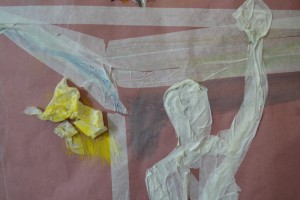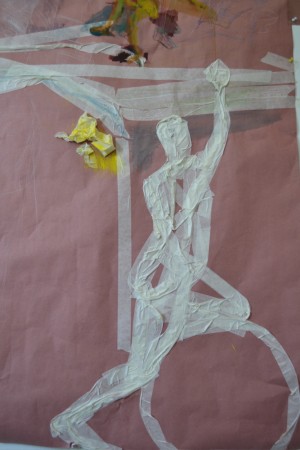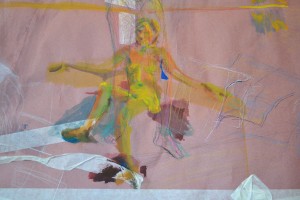The Sacrifice of Abraham: Three Poems

Arielle Tonkin, detail from “Suspension of ThisBelief,” mixed media, 2012. Center. Photo: Laurie Trok.
Note: These three poems are part of the “The Sacrifice of Abraham,” a series of re-tellings of the biblical story of Isaac and Abraham. In each section, a group of rabbis gathers to re-tell and offer commentary on the story, and with each re-telling transforms it into a broader and broader vision encompassing Greek gods, revolutionaries, insurgents, love affairs, and photographic details from current events. The artwork featured here is part of the cycle “Suspension of ThisBelief” from Arielle Tonkin’s recent installation “Archaeology of a Collapsed Page,” mixed media, 2012, and was selected by the writer and photographed by Laurie Trok.
The Life of Isaac

Arielle Tonkin, detail from “Suspension of ThisBelief,” mixed media. September 2012. Created in residency at the Vermont Studio Center. Photo: Laurie Trok.
A group of rabbis hung suspended by orange harnesses from the top of a power-pole on the road to Tenochtitlan. Wringing his hands, one rabbi breathed a commentary on the story of Abraham and Isaac.
As Abraham raised the knife above his head, the rabbi noted, he averted his own eyes so as not to witness the act he was about to perform. At this moment, the rabbi continued, the Three Graces passed above the sacrifice in a zeppelin of their own design which carried, in addition to a compliment of human passengers, an enormous fish tank filled with coral, anemones, and luminous seaweed undulating in the slow current. As the zeppelin passed over the scene, the Graces watched as an angel stopped Abraham’s hand at the very last moment, replacing Isaac with a derelict pump salvaged from an oil rig on the outskirts of Baku, where the first gods crawled up out of the mud, and where today tramps and adolescents dressed as skeletons sit by the roadside eating watermelon.
At the end of his life, the rabbi continued, Isaac lived in a slum on the outskirts of the Sahara. In his last days, his wives baked dozens of loaves of flat bread, which they packed in brown paper bags, with golden raisins and tiny roast chickens called “poussins,” which you can eat whole, bones and all. On the eve of his death, Isaac’s wives rubbed ashes on their foreheads, ululating and throwing throughout the night urns, painted vases, and idols into the street. In the morning, the path was lined with the scattered shards.
Isaac ended his life in leather sandals that had become joined to his feet through ceaseless walking in the desert, and which he did not take off even to sleep, or to lie with his youngest wife, in whose arms he became again the youth who once interpreted the dreams of a demon, tricked and imprisoned by King Solomon after constructing the temple without reward, who spoke to him through a grating in the gutter.
The demon told Isaac a parable in which the Twelve Tribes of Israel emerged dazed from a dilapidated building in a destroyed city and returned to their work at the cash register and at the plough, and behind the handgun, and in front of the handgun, or putting a knife into a living breast, or forging a check, or filling cigarette lighters with lighter fluid and sending them back into the past, like flares or place-markers, or sitting silently in the dark, as in a house of mourning.
Like Mozart, the rabbi continued, Isaac expressed himself in scatological language. Some who heard him returned home, tied an apple and a sandwich into a handkerchief, and were not seen again, only to reappear in legends as wild prophets living on the edge of town halfway across the world. Others ignored what he said, and even mocked him to their companions, picturing him separated from his kind, languishing and humiliated in exile by a stretch of forgotten railway tracks. To these, he would only repeat his maxim that every bone at some point understands it is part of the same all-encompassing skeleton, which no one can make out in its entirety, or determine the creature it forms.
Isaac, the rabbi concluded, once found Mussolini seated in the row in front of him at a performance. He leaned over and tapped the dictator on the shoulder, rebuking him for the annex of Ethiopia. The dictator responded by asking Isaac if he knew that, on the eve of his kingship, Saul, Israel’s first King, had gone to a cheap brothel where he met the woman who would later become the witch of Endor, who told him that man’s genitals were descendents of the biblical plague of frogs, and that reptiles were sons of man who were born when Adam mated with the serpent beneath the Tree of Knowledge. Saul, according to Mussolini, responded to the witch that birds’ feet were the daughters of Eve sired by one of the vultures who ate the liver of Prometheus, and that women’s tears were in the final account no different from the biblical plague of death of the firstborn, as though it were the tears which called forth the death, not the other way around.
The Disciple

Arielle Tonkin, detail from “Suspension of ThisBelief,” mixed media. September 2012. Created in residency at the Vermont Studio Center. Photo: Laurie Trok.
The synagogue, where the rabbis’ discussion of Isaac and Abraham took place, spun floating on the island of garbage growing larger and larger in the Pacific Ocean.
Yes, explained a rabbi who, although it was summer, wore a heavy overcoat translucent at the elbows, in another dimension it may have been possible that the mountain stood near nothing, alone in a desperate landscape. But in this dimension, the rabbi continued, the mountain, on the summit of which Abraham intended to sacrifice his beloved son, stood by the vacant lot where the lovelorn King Solomon burned the Queen of Sheba’s body on a pyre of plane trees and firecrackers. This lot, as excavation later revealed, argued the rabbi pointing at the ground, was also the final resting place of Abraham’s ancestral idols, several of which had even been involved as officers on William Tecumseh Sherman’s march to the Dead Sea, where, with the black water at his back, the general at last gave a speech to his troops. The general spoke of the immortality of the spirit, the confusion of its duration in time and its whereabouts in space, and the location, revealed to him in a dream by a group of satyrs and Hasids, where Jacob, Isaac’s son, stole the blessing of his brother Esau, appearing before his blind father in a camel hair coat to disguise his hairless arms.
At that time, the head rabbi found himself in a scandal ignited by the heretical opinions of one of his disciples. The radical student, inspired by a wandering Taoist who sold green sparklers in an abandoned plaza and murmured a cryptic story about creatures at the bottom of the sea, had begun to appear in the village square with a shocking contention. The student claimed that Mt Moriah, destined to be the site of the sacrifice which, only narrowly averted, made possible the fate of every son of the future, was in fact only a figment of Abraham’s imagination, while Isaac, and anyone else looking towards the east, saw only the parched desert of the wilderness, in which the disoriented mind recognizes the blankness at its own depths.
Each of us, reasoned the disciple, citing an argument made by an outlaw who held his own yeshiva in a slum shack lined with plaster statues of saints, has heard mysterious voices speaking to us at moments of heightened solitude. And furthermore, the disciple continued, Ulysses, on his expedition across the Straits of Gibraltar in search of the fulfillment which lures any dreamer from home, reported that after three days at sea, he began to hear incomprehensible, but nonetheless distinct and familiar voices, sounding all around him like benevolent sirens. And was not the murderous intention, demanded the disciple, only a voice deep inside the spirit of Abraham, the failed killer, himself?
Protesters gathered outside the synagogue threw rotten eggs at the disciple when he passed in the street, and forced him to wear a suggestive hat made from the skin of a skunk in disgrace. The radical nonetheless gathered around himself a group of his own disciples who began distributing leaflets on Times Square, by the temple of Angkor Wat, and on the banks of the Danube. The disciple taught his followers beneath a white tent illuminated by bright blue fluorescent lights, running his voice through a monumental PA system designed by the impostor magician Smardis, whose model of the cosmos was superseded only when the heretic Galileo attempted to climb a stone tower which, he had reason to suspect, contained a man with breasts.
The disciple, the rabbi continued, was accompanied only by a fool who was compiling a book of jokes in which God appears with incomprehensible extra limbs, or with animal features, or with his head and eyes wrapped in a turban. The two of them begged for quarters to spend on lunches of ham sandwiches and coffee, which they ate while sitting, desolate and yet animated by the truth, in the gutter on Broadway, as yellow buses passed by carrying the next load of fortune-tellers and asylum-seekers to be devoured by the Minotaur, a creature with the body of a man and the head of a dump truck, who lived at the base of the Empire State Building in a labyrinth made from aluminum siding and recycled plastic bottles. At this time, the rabbi concluded, Franz “Frank” Schubert had only just purchased the New York Knicks, and Beethoven had only begun to compose an ethereal sonata for a beloved who was never identified.
The Fool
As the rabbis’ discussion concluded, a demon and a fool passed by the synagogue. The demon scraped his violin beneath the window for a few coins or a handful of seeds. The cantor came out, and the fool told a parable on the story of Isaac and Abraham.
Four men met a soul.
The first brought it home, set it on a windowsill in the sun, and watered it that it might grow.
The second smashed it with a bat until nothing remained.
The third sat it in a chair and asked it question after question.
The fourth walked by as if there were nothing to see.
Was not each man meeting his own soul?
Artwork: Arielle Tonkin, detail from “Suspension of this Belief,” mixed media (acrylic, birch ply, rosin paper, colored pencil, guache, charcoal, tape). September 2012. Created in residency at the Vermont Studio Center. Photo: Laurie Trok.
Earlier selections from this series have appeared in The White Review and in AGNI.
Alexander Nemser is a writer, poet, performer, and educator living in Boston. His poems have been published in The Atlantic Monthly, Paris Review, New York Times and N + 1, and his literary essays have appeared in The New Republic and AGNI. The New Yorker described his one-man show, “Moshe Feldstein, Icon of Self-Realization,” as a “funny, funny piece of work” when it premiered at the Cherry Lane Theater in 2001.
Arielle Tonkin is an artist and an educator who holds a BA in visual arts and conflict studies from the University Professor’s Program at Boston University. Recent fellowships and residencies include Yeshivat Hadar in New York , and the Vermont Studio Center in Johnson, VT. She is the public programs coordinator at The Magnes Collection of Jewish Art and Life at the Bancroft Library, University of California, Berkeley, with experience at the Peabody Museum of Archaeology and Ethnology at Harvard University and the Haifa Museum of Art. Arielle taught at Brandeis University’s BIMA program in 2012, and will teach at the National Havurah Committee Summer Institute in 2013. Arielle’s dual practices of traditional text study and artmaking inspired the 2012 iteration of the installation Archaeology of a Collapsed Page.
![[the current issue of ZEEK]](../../image/2/100/0/5/uploads/leftistethicistgraphic-52842c6a.png)
- 5000 Pages of Zeek
- Founded in 2001, Zeek was the first Jewish online magazine, and we have over 5000 pages online to prove it, all available free of charge. Read more in the Archive.
More articles in
Arts and Culture
- Euphoria, Curiosity, Exile & the Ongoing Journey of a Hasidic Rebel: A Q & A with Shulem Deen
- Poet Q, Poet A: Jews Are Funny! Six Poets on Jewish Humor, Poetry & Activism and Survival
- Tackling Hate Speech With Textiles: Robin Atlas in New York for Tu B’Shvat
- Fiction: Angels Out of America
- When Is an Acceptance Speech Really a Speech About Acceptance?

